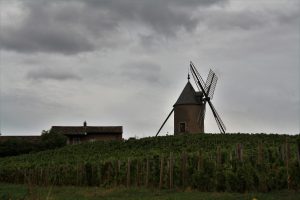Beaujolais is a section of Wine Country just north of the French city of Lyon. It is well known for the Beaujolais Nouveau released each November. In Beaujolais, it is the celebration of the end of the harvest, without any pretention. It’s a great marketing gimmick and is the inspiration for parties all over the French-speaking world, but these wines obscure the quality of some excellent wines made from the Gamay grape in this region.
A slightly chilled Beaujolais Villages goes well with a barbecue on a warm summer evening, but these wines aren’t very memorable, either. The best of Beaujolais comes from the crus, 10 appellations in the northern end of the region. All of them are named after villages (Chenas, Julienas, Morgon, Brouilly, etc.) Well, all but one: Moulin à Vent, which means windmill. And not just any windmill, but a specific one that became the emblem of this cru when the appellation was established in 1936. As noted, these folks have a flair for marketing.
The famous windmill of Moulin à Vent.
The windmill in question sits on a hill overlooking a wide valley, full of vineyards, in the town of Romanèch-Thorins. Right across the road from the windmill is Château Portier, whose wines will provide a good introduction to this well-regarded region of Beaujolais. (Because it is the closest to the windmill, the owners of Château Portier are the official custodians of the landmark.)
One of the outbuildings at Chateau Portier.
The proprietor is Denis Chastel-Sauzet, who is the president of the Moulin à Vent vintners association. We’re not sure what the President’s duties entail, but it is a good indication that the other winemakers hold M. Chastel-Sauzet in high regard. The building that houses the winery is from the 19th century, with extensions that were there in the 16th and 17th centuries. You can walk around the grounds, which offer pleasant views of these older buildings and of the valley.
The tasting room will remind no one of a Napa palace. It’s a bit dank but it is functional. And Château Portier bottles wines from all around the Beaujolais crus, in addition to several from Moulin à Vent. It’s a better introduction to the quality wines of the region than in the Caveau de Moulin à Vent (the local winemakers’ cooperative) just down the road.
Many critics would say that the finest Beaujolais wines come from Moulin à Vent. While we appreciate other crus, especially Morgon, we would be inclined to agree. There is a richness in the mouthfeel in these wines that make them much more interesting than the easy-going Beaujolais Villages and certainly more so than Beaujolais Nouveau. Top end Beaujolais wines deserve to be in any collector’s cellar and the best of them are age-worthy and can accompany many meals, from steak to salmon. This is not to say that Château Portier is among the best of the region, but this winery is a worthy destination for a visitor who wants to see the famous moulin à vent (the windmill) and learn about the wines.

